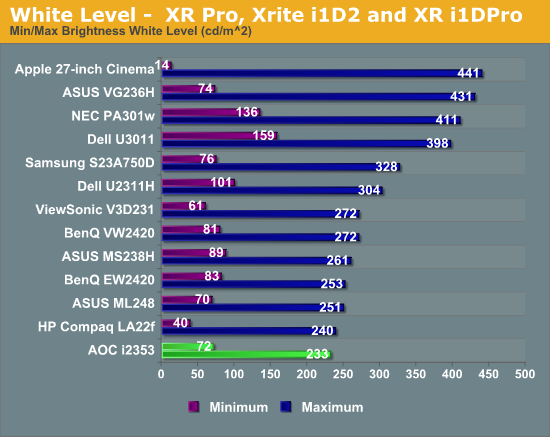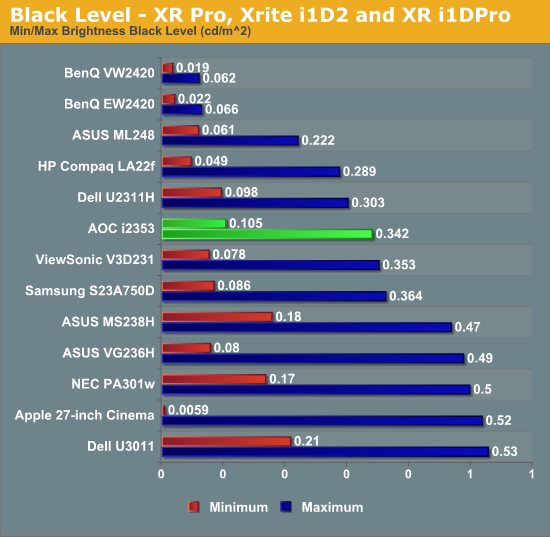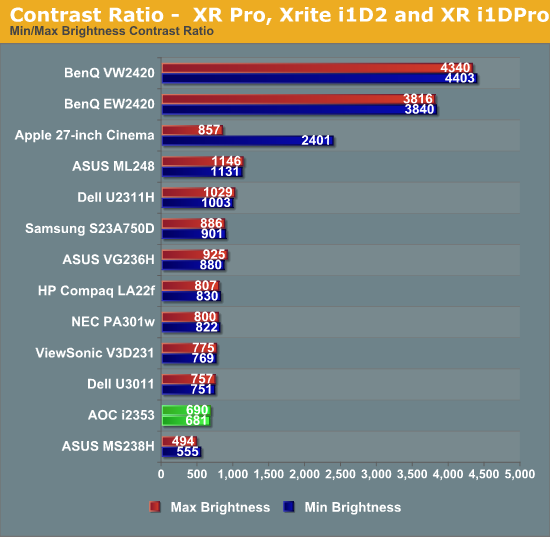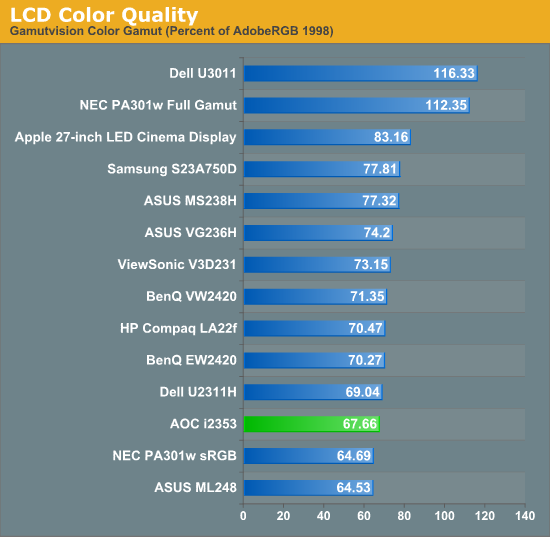AOC i2353Ph - IPS for a nice, low price
by Chris Heinonen on January 30, 2012 12:40 AM ESTPeak Levels, Contrast, and Color Gamut
The brightness uniformity of the AOC was overall good, but just how bright can the AOC go? With it set to user mode, and the backlight raised all the way up, I only managed to get 233 nits out of the display with a solid white screen. Since it is a matte surface and not glossy, reflections should not be a big issue and this level of light should be more than enough for most people. Unless you have direct sunlight on your display I don’t think most people would need more light output than it provides.
Turning the backlight all the way down left us with 72 nits of light output, which lets us know we can turn the display down enough for print work, or a completely dark environment, without having an image that is too bright for what we are working on.

After the black uniformity tests, I was a little bit worried about what the minimum black levels would be, and it looks like I was correct on that. With the backlight set to maximum, and pure black screen gave us 0.342 nits of light, which is pretty bright for a black screen. Lowering the backlight all the way down to minimum took the black level down to 0.105 nits, which is still high. This is similar to the last eIPS display that came past my desk (The Dell U2311H), and we discussed that black levels are an area that IPS still needs to work on. For comparison, the recent VA panels from BenQ with an LED backlight have a black level at maximum brightness, 0.066 nits, that is still far lower than the AOC can put out with the backlight level at minimum. If deep, rich black is important to you, you probably will want to look at an option other than the AOC, or even IPS altogether.

Once I saw the black levels, I had a feeling that the contrast levels were going to leave something to be desired. Looking at what the AOC can produce, we can’t quite hit 700:1 for the contrast ratio with the backlight at high or low power. This isn’t really surprising given the price point of the AOC, and the use of an IPS panel.

As we discussed in the calibrated results section, the color gamut on the AOC is a bit smaller than the sRGB colorspace. When we measure against the AdobeRGB colorspace, we expect to see a monitor be able to reproduce around 71% of that if it is sRGB capable, but with the AOC we only saw 67.7% coverage. This is what is leading to the larger average dE error, as it can’t produce some of the colors we are looking for, but it still has a lower median dE since it does a good job with the colors it can produce.











71 Comments
View All Comments
cashkennedy - Monday, January 30, 2012 - link
Might want to clarify that its too much lag for FPS gaming, as Im pretty sure a latency that small in an RPG or strategy game is not going to have any effect.Jedi2155 - Monday, January 30, 2012 - link
Where did you get the idea that 5ms GTG response time is too much for gaming? The more important consideration IMO is input lag.mathew7 - Monday, January 30, 2012 - link
He said "The lag is a little bit too high for hard core gamers". He measured it at 16ms delay compared to CRT. This is not pixel response that every manufacturer wants and declares it low. Input lag is not specified by manufacturers, and only some reviews (this included) actually measure it.As for categories, FPS is not the only category that benefits from low lag. Racing is another and I'm not talking about the NFS series where a mistake slows you down a bit (in Underground 2 a friend of mine managed to win once by riding each wall in each turn), but where a mistake ends your race (sims).
Samus - Monday, January 30, 2012 - link
Still no reason to replace my $400 Doublesight DS-2700W 27" PVASabresiberian - Monday, January 30, 2012 - link
Umm - who suggested it would be?therealnickdanger - Monday, January 30, 2012 - link
No one, he just wanted to brag.jleach1 - Tuesday, January 31, 2012 - link
Back in the grand turismo days, you used to be able to buy a super car, change the transmission tuning to all acceleration, and the tape the controller stick to ride the wall for Le Mans races.Those were the days... (feeling nostalgic here...not to cheat.)
JonnyDough - Monday, January 30, 2012 - link
I for one, think that 5ms is too slow for gaming. I won't buy a monitor for a gaming system over 3ms, 2 is preferred. Even some movies can show some ghosting at 5ms. I can tell the difference.jleach1 - Tuesday, January 31, 2012 - link
I haven't seen a display with that low of lag. The value of a manufacturers advertised display lag is a joke at best.aguilpa1 - Tuesday, January 31, 2012 - link
I have 3 120Hz Alienware OPTX2310's with rated 3ms refresh rates. It is true that the way manufacture's measure those rates is less then accurate but since it is true of all monitors it is still a good idea if your gaming to get the fastest timings even if it turns out to be more like 5 or 6ms on a 3ms rated overall. You can tell the difference. Also I believe the 2310's even have a better gamma (mid 70's) then this AOC does which is very disappointing for an IPS panel.